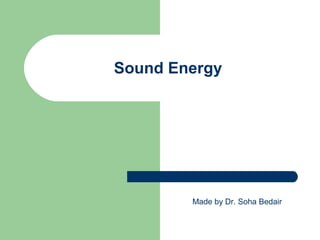
Sound energy
- 1. Sound Energy Made by Dr. Soha Bedair
- 2. What is sound? Sound is – A form of energy made by vibrations. – When an object vibrates it causes the air particles around it to move. – These particles bump into particles close to them and this continues until they run out of energy.
- 3. Sound creates : Compressions & rarefactions:
- 4. Try this: Put your finger on your neck and say “aah” as loud as you can. Now say it as soft as you can. You can not only hear the sound, but you can feel the vibration inside your throat.
- 5. How does sound travel? Sound travels through all forms of matter— gases, liquids and solid. These are called the medium. Sound cannot travel through a vacuum.
- 6. Volume: It is measured using sound level meter The unit for measuring the volume is decibels(dB)
- 7. How does sound travel? Sound passes through the medium as longitudinal waves. While light travels by transverse waves
- 8. How do musical instruments create sound? It depends on the type of instrument. There are four types. – Woodwind – String – Percussion
- 9. Woodwinds Instruments Woodwinds make music by blowing on the top of the instrument or on a reed. Flute Oboe Clarinet Bassoon Piccolo
- 10. Percussion Instruments Percussion instruments make music by striking, shaking or scraping them. Drum Cymbals Tambourine Xylophone Piano Maracas
- 11. String Instruments Strings make music by plucking or strumming the strings. Violin Cello Electric Guitar Guitar Harp
- 12. Pitch, frequency and amplitude: Pitch: it determines how high or low the sound is. is produced by short objects. is produced by long obj. tight( stretched)objects. Loose obj.
- 13. Frequency: It is number of vibrations in one second. As the number of vibrations increases the frequency and pitch increases.
- 14. Louder Softer How else can we change sound? We can make it louder or softer by changing the amplitude of the height of the wave. The higher the amplitude, the louder the sound. The lower the amplitude the softer the sound.
- 15. Echo & how the sound energy is absorbed: Echo: is when the sound bounces back from a hard surface. If sound hits soft surface is absorbed more>>>> than hard surfaces.
- 16. How is sound transmitted? The sound waves have energy. The sound waves needs a matter to be transmitted.(solid, liquid or gas). We call the matter (medium).
- 17. Sound transmission through different media:
- 18. Parts of the ear: cochlea
- 19. How we hear a sound? When the sound wave reaches our ear drum, it hits it and our ear drum starts to vibrate. Then the three bones attached to the ear drum starts to vibrate. The cochlea then translates these vibrations into signals. The brain receives those signals by nerves. Then the brain translates these signals into sound.